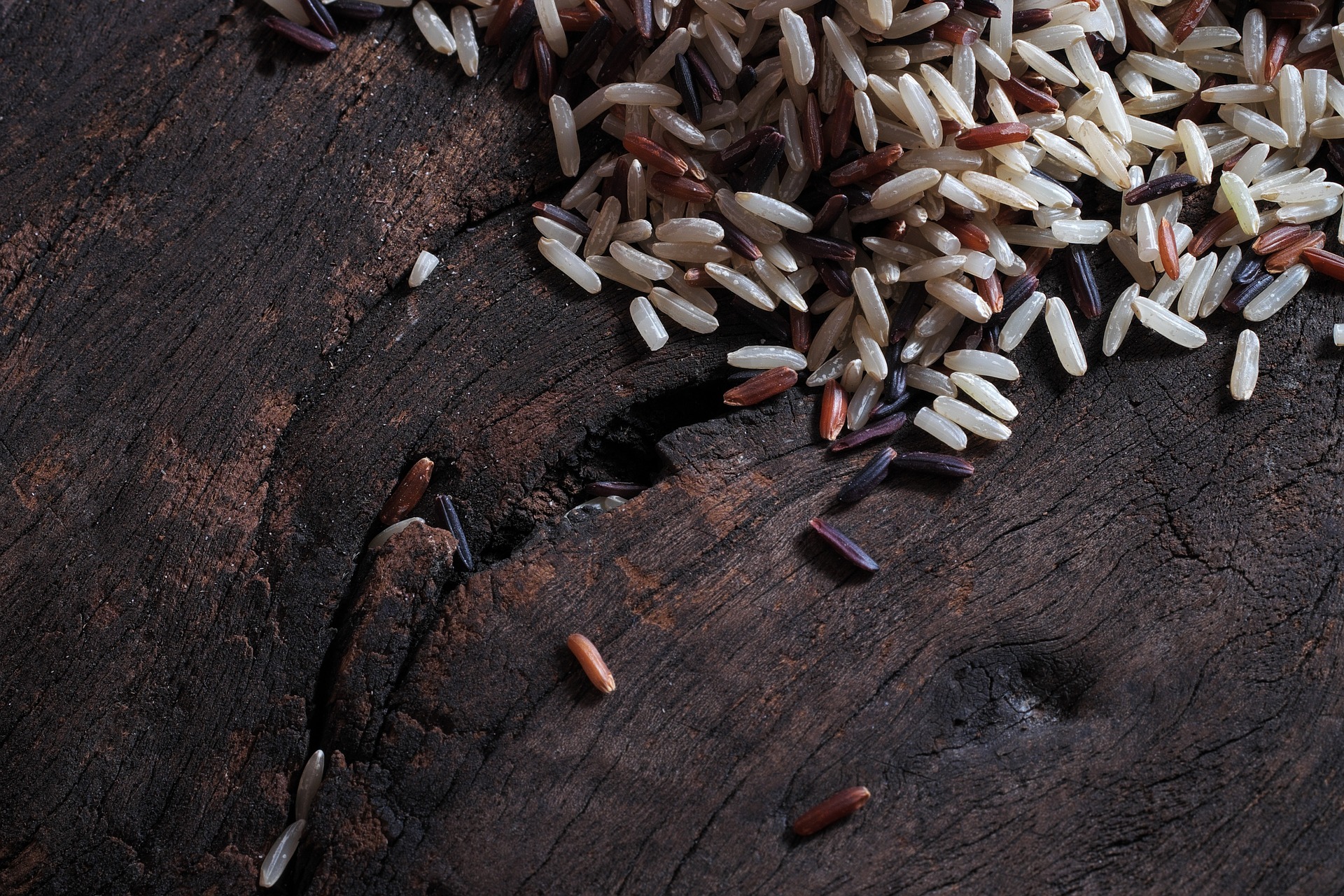There are countless varieties of rice around the world. We are presenting 7 very common varieties in terms of their nutritional content.
For a large part of the world’s population, rice is on the menu every day. In many Euriopean countries, rice has to share its place with pasta, potatoes and bread. Since rice is a gluten-free food and very digestible to boot, the side dish is actually the ideal candidate for some variety on the plate. Parboiled, basmati, wild rice and co. – which rice is actually particularly healthy?
Sushi rice, parboiled rice
As far as the health factor is concerned, white rice is more or less on the same level as white bread. White rice is not a natural product, but the result of a process in which the husk, bran and germ have been removed. In the process, vitamins and minerals are literally polished down, leaving only empty carbohydrates and a few proteins. White rice is, strictly speaking, nothing more than “filler”. And it’s not even very good at that: According to studies, white rice stays in the stomach for a shorter time than other types of rice, while blood sugar levels skyrocket. As a result, hunger sets in again soon after eating. Although the so-called pairboiling process can push some of the nutrients into the rice interior, it loses its stickiness as a result. Unfortunately, this also makes the popular sushi rice virtually worthless in terms of nutritional physiology, which puts it in last place among the healthiest types of rice.
Risotto rice
Risotto rice (Arborio) is mainly grown in Italy and is characterized above all by its creaminess. The smooth texture is due to the high starch content. This is a minus point for the glycemic index, but risotto rice can score in other areas: With 9 grams of protein per 100 grams, it is the protein bomb among rice varieties (white rice contains 7 grams). Risotto rice has no significant vitamin content. Since the delicious taste of a classic risotto is also and primarily due to plenty of butter and Parmesan, one should keep a bit of an eye on the total calories. Of course, nothing stands in the way of occasional enjoyment.
Jasmine rice
Jasmine rice smells wonderful and is also a bit healthier than its white rice counterparts mentioned above. Although this variety has also been deprived of nutrients, at least it provides iron and niacin. The latter is important for energy metabolism as well as for cell division. Jasmine rice (like the varieties above) should not be eaten daily. According to studies, people who eat white rice every day have an eleven percent higher risk of developing type 2 diabetes. The risk decreases when switching to brown rice, i.e. whole grain varieties. So if you love the typical jasmine scent but want to go a little healthier, you should choose the natural variety.
Basmati rice
Basmati rice is slightly softer and thinner than jasmine rice and tastes slightly nutty. Finally, there’s momentum on the nutrients front: Folic acid, copper, iron, zinc, vitamin B6 and thiamine are all found in comparatively acceptable amounts in the small grain. Thiamine is needed by the body to convert carbohydrates into energy. Compared to other rice varieties, basmati contains less arsenic. A heavy metal that has been linked to diabetes, heart problems, and certain cancers. Basically, unless you eat large amounts of rice every day, the amount of arsenic is usually harmless. Important: Wash rice thoroughly before cooking! Basmati is also easy to digest and is therefore suitable for people with intestinal complaints such as irritable bowel syndrome.
Wash rice properly
To remove impurities from rice, place it in a bowl or pot and cover well with cold water. Mix until the water turns milky – this is the excess starch. Then drain and boil in fresh water.
Brown rice
Now it’s getting really healthy, because brown rice was allowed to keep its fiber-rich bran layers during the husking process. These layers basically contain all the rice superpower. There are the flavonoids apigenin, quercetin and luteolin. These compounds protect against chronic diseases, scavenge free radicals and are even said to inhibit certain types of cancer. One serving of brown rice contains almost all the important minerals and vitamins and also covers almost the entire daily requirement of manganese. The trace element is vital for numerous processes in the body, including bone formation, wound healing, muscle contraction metabolism, nerve function and blood sugar regulation. A deficiency, on the other hand, can lead to growth disorders, flabby skin, bone demineralization and infertility. In addition, brown rice keeps you full for a long time and keeps blood sugar in check, thus protecting against diabetes.
All in all, brown rice is a valuable as well as inexpensive food that deserves more attention due to its numerous health benefits. So if it’s simply rice with no frills, brown rice is (almost) the healthiest kind of rice. Almost? Yes, because it can be even healthier….
Wild Rice
Botanically speaking, wild rice is a grass. Nevertheless, it should not be missing from this list. Compared to other varieties, wild rice is much more expensive, has a strong aroma and is very firm to the bite. It is rarely served plain, but mixed with other types of rice or vegetables. Wild rice tastes very healthy and in fact it is. It has 14 grams of protein per 100 grams (cooked), packed into just over 100 calories. It also contains all the amino acids and plenty of dietary fiber, so wild rice keeps you full for a long time, making it a slimming product. In addition to the usual vitamins and minerals, it contains effective radical scavengers. An analysis found that the antioxidant activity of wild rice is 30 times higher than that of white rice. This makes wild rice a fountain of youth that protects against cancer and heart disease.
Black rice
We have now arrived at the first place of the healthiest rice varieties: black rice. This was already known in ancient China, which is why black rice was also called the “forbidden rice”. It was reserved only for the royal family because of its valuable properties. What are they? For example, anthocyanin – the pigment that gives rice its black-purple color and has been shown to protect against heart attacks, regulate cholesterol levels and possibly prevent cancer, especially colon cancer. All red and purple foods contain anthocyanin – for example, eggplant, cherries, blueberries or red cabbage. Compared with all other types of rice, black rice thus has the strongest antioxidant activity.
In addition, it contains 23 other protective phytochemicals, all of which promote healthy cells, healthy eyes, beautiful skin, and youthful vigor. The unique combination of ingredients in black rice is considered so cleansing that researchers believe it provides protection against osteoporosis, as well as powerful liver and kidney detoxifying properties. For example, black rice could play a role in alcohol withdrawal in the future. Given this, the (common) vitamins and minerals it contains are not worth mentioning. Black rice, which is always whole grain rice, therefore rightly has superfood status. In terms of sustainability, it is important to look for fairly traded and produced products in organic quality when buying.
Long grain, round grain, medium grain
The designations long-grain, round-grain and medium-grain rice provide information about the nature of the rice grain. Long grain (e.g. Basmati and Jasmine): at least 6 to 8 millimeters long, very narrow in diameter. Medium-grain rice is 5 to 6 millimeters long, contains more starch and soaks up more liquid when cooked – it is therefore used to make risotto that is supposed to be nice and slimy. Sushi rice is also a medium grain. Round-grain rice has bodies 4 to 5 millimeters long and is sold (in addition to risotto rice and sushi rice) as rice pudding, among other things.
Sources:
- 1. Pletsch EA, Hamaker, BR. Brown rice compared to white rice slows gastric emptying in humans. European Journal of Clinical Nutrition. (2017, aufgerufen am 22.7.2021)
- 2. Nutritionix. Nutrition facts and Information for Arborio Rice (aufgerufen am 20. 7.2021)
- 3. USDA Food Data Central: Jasmin Rice Nutrition Facts (aufgerufen am 20.7.2021)
- 4. Hu EA, Pan A, Malik V, Sun Q. White rice consumption and risk of type 2 diabetes: meta-analysis and systematic review. British Medical Journal. (2012, aufgerufen am 22.7.2021)
- 5. USDA Food Data Central: Basmati Rice Nutrition Facts (aufgerufen am 20.7.2021)
- 6. Lai PY, Cottingham KL, Steinmaus C, Karagas MR, Miller MD. Arsenic and Rice: Translating Research to Address Health Care Providers’ Needs. The Journal of Pediatrics. (2015, aufgerufen am 22.7.2021)
- 7. Ravichanthiran K, Ma ZF, Zhang H, Cao Y, Woon Wang C, Muhammad S, Aglaggo EK, Zhang Y, Jin Y, Pan B. Phytochemical Profile of Brown Rice and Its Nutrigenomic Implications (2018, aufgerufen am 22.7.2021)
- 8. Nutrition Data: Rice, brown, long-grain, cooked Nutrition Facts (aufgerufen am 20.7.2021)
- 9. Sun Q, Spiegelman D, van Dam RM, Holmes MD, Malik VS, Willett WC, Hu FB. White rice, brown rice, and risk of type 2 diabetes in US men and women. JAMA Internal Medicine. (2010, aufgerufen am 22.7.2021)
- 10. Nutrition Data. Wild rice, cooked, Nutrition and Facts (aufgerufen am 22.7.2021)
- 11. Qiu Y, Liu Q. Antioxidant activity of commercial wild rice and identification of flavonoid compounds in active fractions. Journal of Agricultural and Food Chemistry. (2009, aufgerufen am 22.7.2021)
- 12. Cassidy A, Mukamal KJ, Liu L, Franz M, Eliassen AH, Rimm EB. High anthocyanin intake associated with reduced risk of myocardial infarction in women. Circulation. (2013, aufgerufen am 22.7.2021)
- 13. Ghasemzadeh A, Karbalaii MT, Jaafar HZ, Rahmat A. Phytochemical constituents, antioxidant activity, and antiproliferative properties of black, red, and brown rice bran. Journal of Agricultural and Food Chemistry (2018, aufgerufen am 22.7.2021)
- 14.Pereira-Caro G, Watanabe S, Crozier A, Fujimura T, Yokota T, Ashihara H. Phytochemical profile of a Japanese black-purple rice. Journal of Agricultural and Food Chemistry. (2013, aufgerufen am 22.7.2021)
- 15. de S Dias AL, Pachikian B, Larondelle Y, Quetin-Leclercq J. Recent advances on bioactivities of black rice. Clinical Nutrition and Metabolic Care. (2017, aufgerufen am 22.7.2021)
— article source: fitbook.de/picture: pixabay.com
This post has already been read 1948 times!



